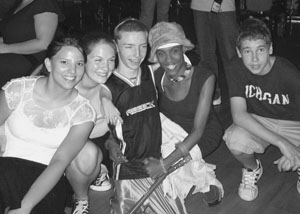Introduction

Success stories prove that some people with disabilities overcome multiple barriers to college and careers. However, this group continues to be underrepresented in challenging academic and career fields, such as science, technology, and engineering. The DO-IT Scholars program integrates activities for young people who have disabilities that, together, promote positive postschool outcomes. The disabilities of participants include sensory impairments, mobility impairments, health impairments, attention deficits, Asperger's Syndrome, and learning disabilities.
DO-IT (Disabilities, Opportunities, Internetworking, and Technology) serves to increase the participation of individuals with disabilities in challenging academic programs and careers. It was founded and continues to be directed by co-author Sheryl Burgstahler, Ph.D., at the University of Washington in Seattle. DO-IT promotes the use of computer and networking technologies to maximize independence, productivity, and participation in education and employment. Since 1992, the DO-IT Scholars program has provided students with disabilities with the tools and skills needed for postsecondary and career success through interventions that include technology access, live-in summer programs, peer and mentor support, college preparation activities, and work-based learning.
Repeated funding from the National Science Foundation has resulted in DO-IT strengths in the fields of science, technology, engineering, and mathematics (STEM). DO-IT's Alliance for Access to STEM (AccessSTEM) promotes the participation of people with disabilities, including the DO-IT Scholars, in STEM fields. For more information on AccessSTEM and for a searchable Knowledge Base of questions and answers, case studies, and promising practices, consult the AccesssSTEM page.
DO-IT has evolved into a collection of projects and programs to increase the number of people with disabilities who:
- use technology as an empowering tool
- communicate with peers and mentors in a supportive electronic community
- develop self-determination skills
- succeed in postsecondary education and employment
- pursue careers that were once considered unavailable to them, such as science and engineering
- have opportunities to participate and contribute in all aspects of life
This manual was developed to help you create summer study, work-based learning, and e-mentoring programs for youth. Although DO-IT focuses efforts on college-based teens with disabilities, activities, forms, and publications can be adapted for other groups. Chapter One provides an overview of research that supports DO-IT practices. The chapters that follow share how DO-IT employs evidence-based practices in a cohesive set of programs and activities for students who have disabilities. Within those chapters you will see how we've put research into practice to promote the success of students with disabilities as they transition from high school to college and careers. The last chapter shares information on resources that include websites, references, and a collection of DO-IT publications and video presentations, such as How DO-IT Does It, DO-IT Pals, and Opening Doors: Mentoring on the Internet. Appendices include ready-made forms and other documents that can be adapted for use in your program.
Organizational details shared in this book have been implemented for more than fourteen years at the University of Washington in Seattle. Applying these practices can promote the development of self-determination and technology skills that contribute to success in college, careers, and independent living. Please note that including content in sections and on documents and forms in this book does in no way suggest that they are applicable to any other program. Administrators should seek counsel from attorneys and decision-makers of sponsoring organizations to determine the appropriate policies and procedures for their transition programs.
Much of the content of this book is duplicated in other publications, training materials, and web pages published by DO-IT at the University of Washington, most of which can be found within the comprehensive website at www.washington.edu/doit. Permission is granted to modify and duplicate these materials for noncommercial purposes provided the source is acknowledged.
An electronic version of this book is available at Creating a Transition Program for Teens: How DO-IT does it, and how you can do it too. Related videos and brochures are available on the Resources page. For additional information and resources on technology, education, and employment for people with disabilities, visit the DO-IT website at www.washington.edu/doit.